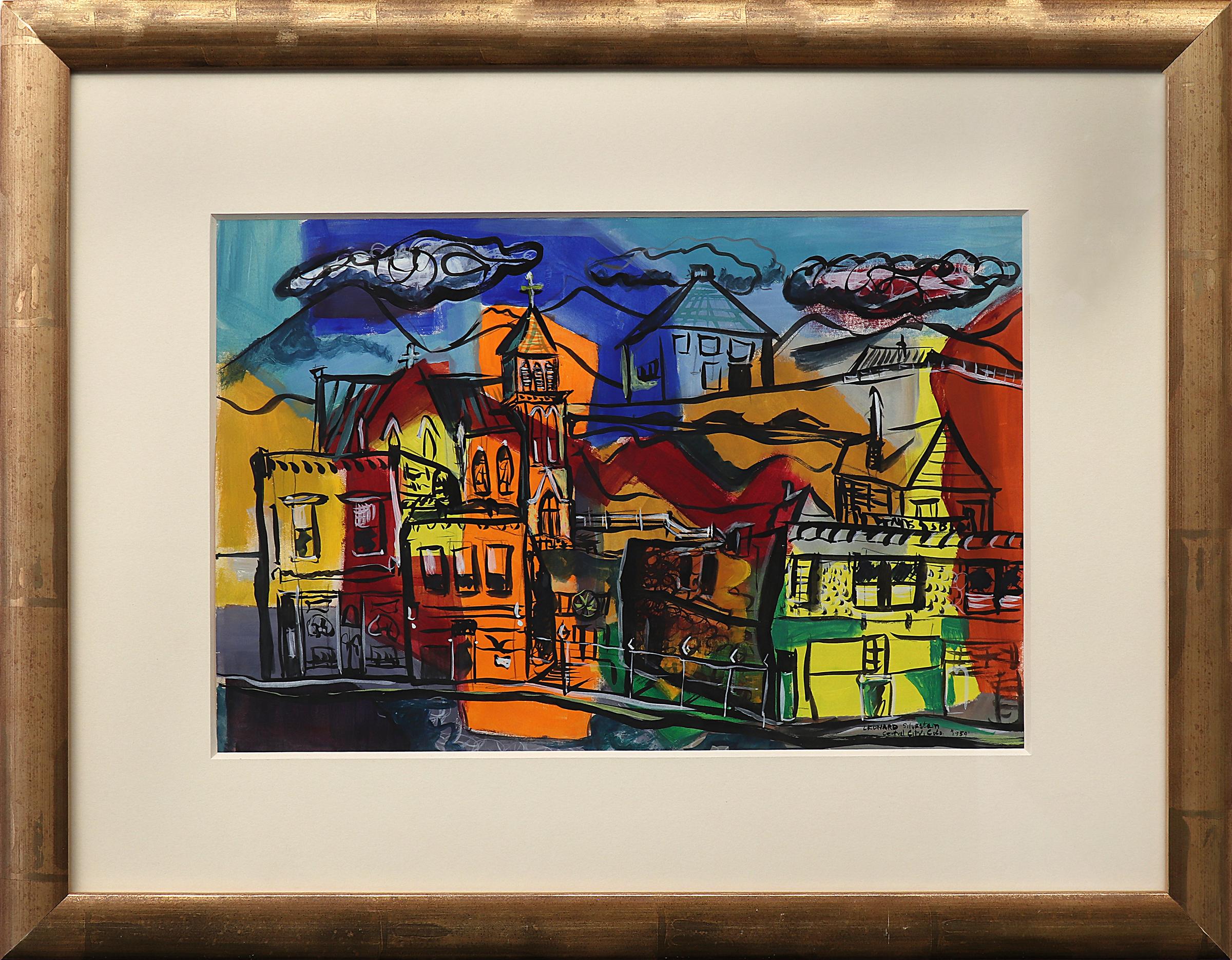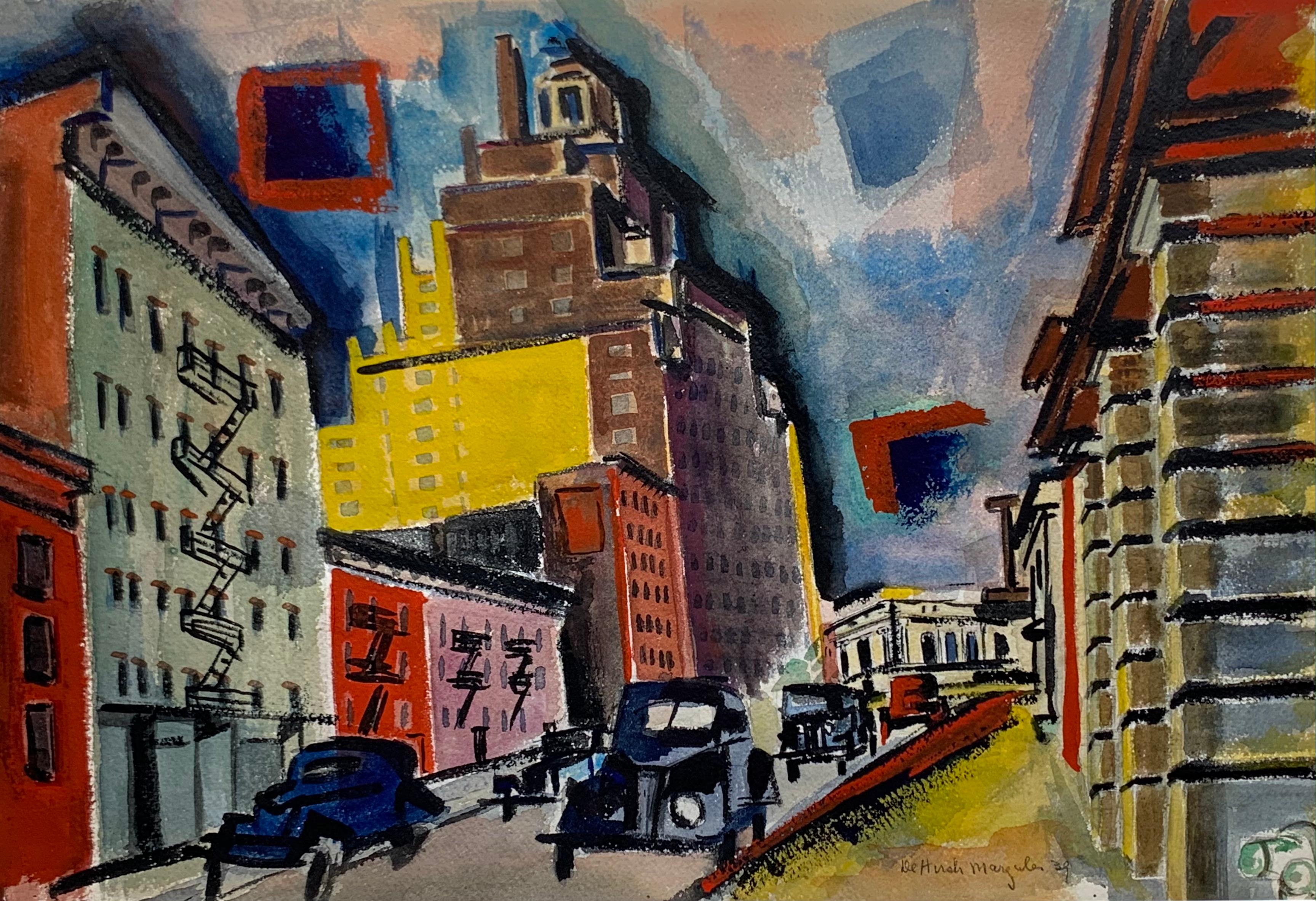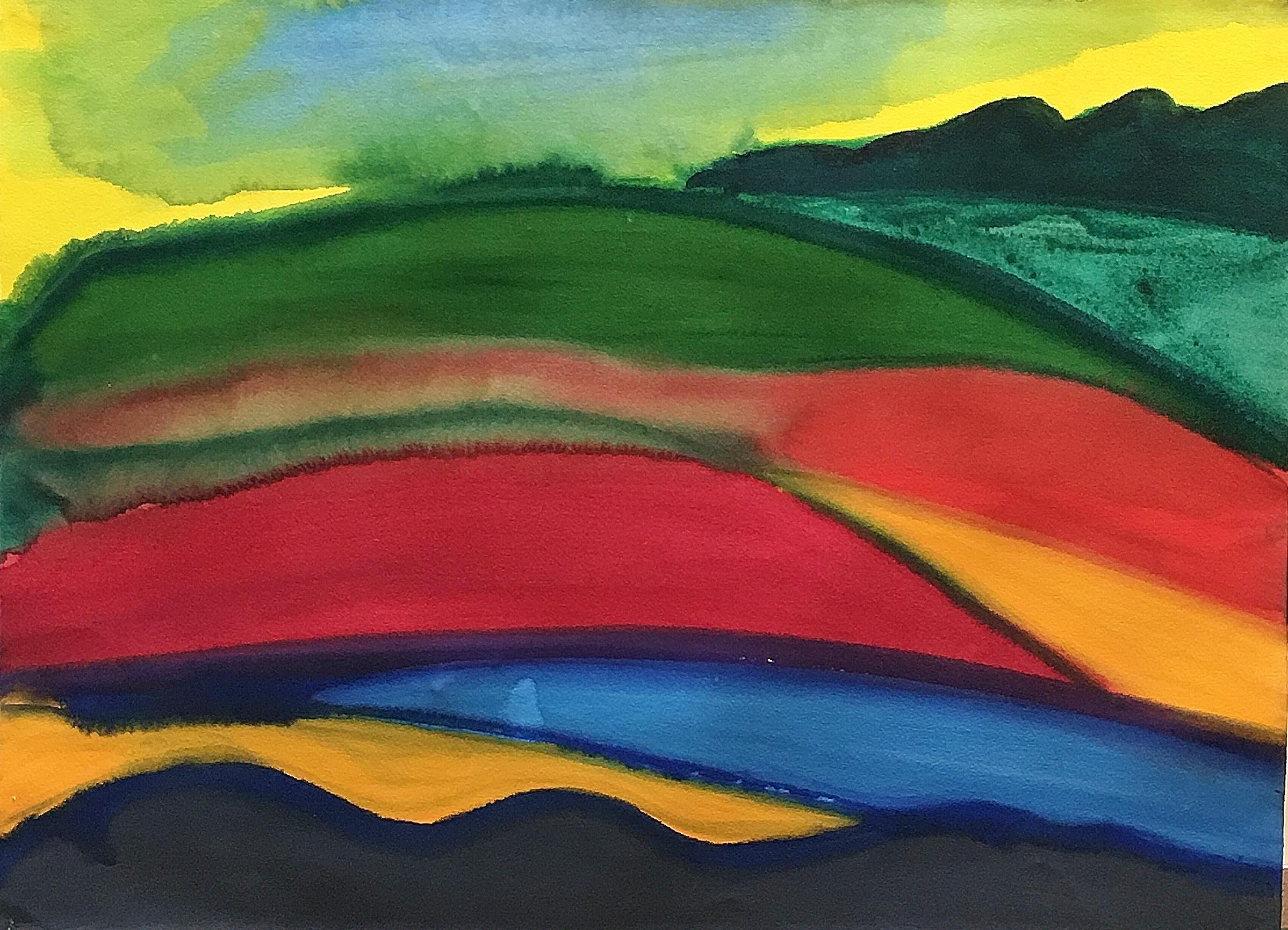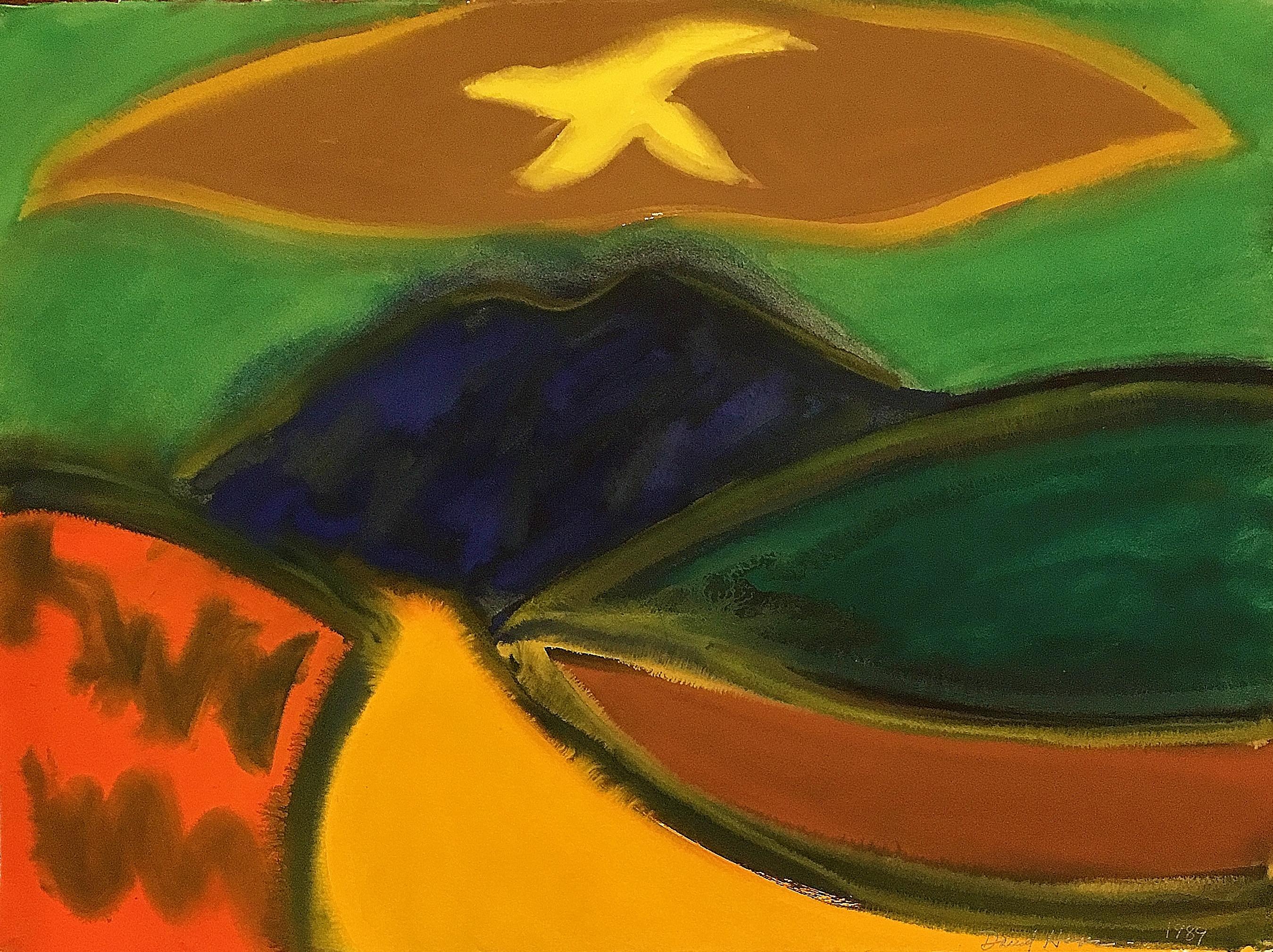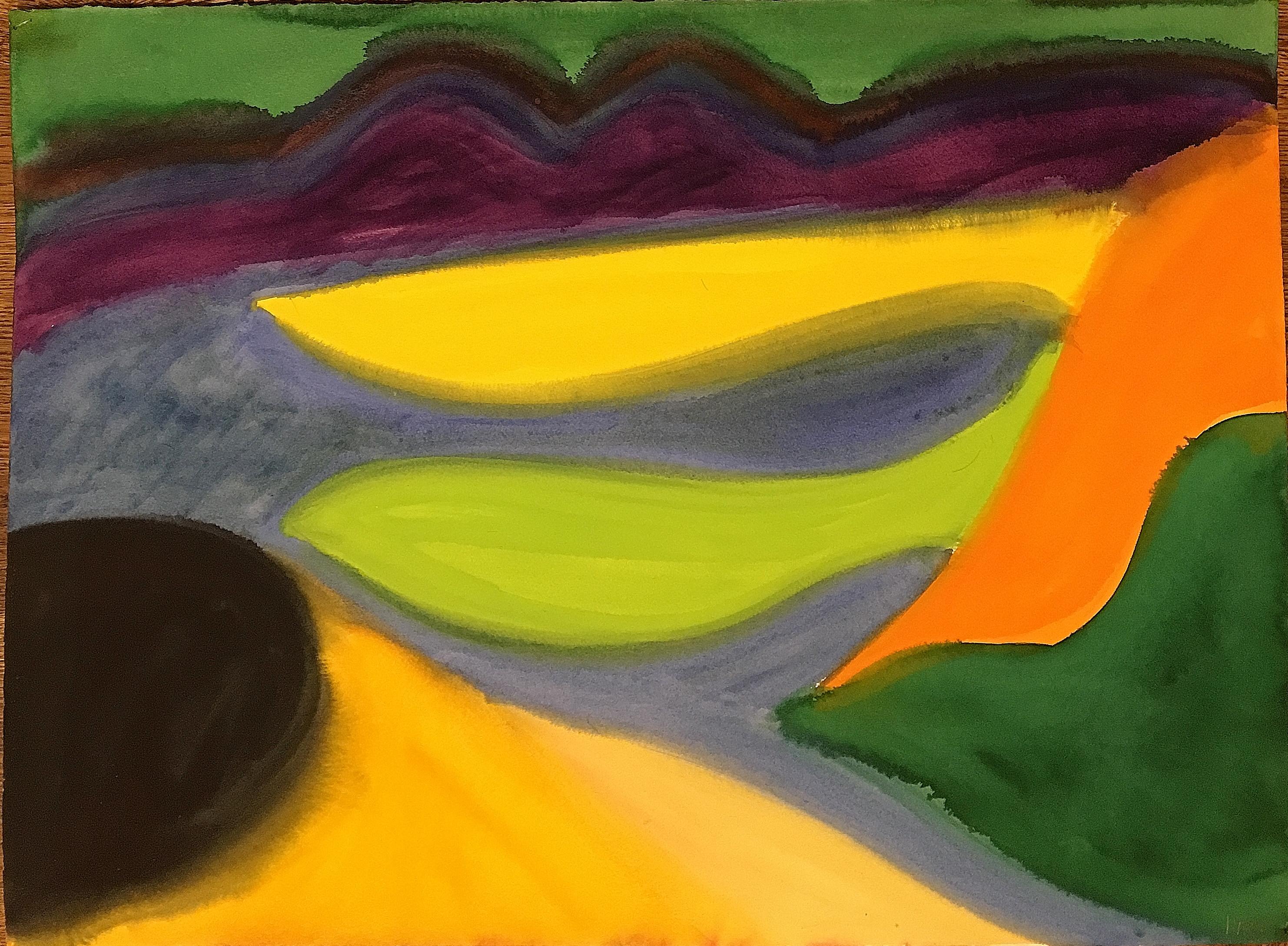Items Similar to Old Mine and Houses, Cortez Colorado, Modernist Abstract Landscape Watercolor
Want more images or videos?
Request additional images or videos from the seller
1 of 16
Richard AyerOld Mine and Houses, Cortez Colorado, Modernist Abstract Landscape Watercolor
About the Item
20th century modernist watercolor painting depicting an old mine and houses in Cortez, Colorado by Richard K. Ayers with colors of blue, green, gold, and brown. Presented in a custom frame with all archival materials, outer dimensions measure 36 ½ x 30 ½ x ¾ inches. Image size is 24 ¾ x 18 ¾ inches.
Painting is clean and in very good vintage condition.
About the Artist:
Richard K. Ayers (1921-2003) studied art at Miami University of Ohio and Northwestern University before moving to Colorado in the 1940s.
During his time at the University of Denver, he studied with Vance Kirkland and William Sanderson. He went on to exhibit nationally before founding a commercial art and public relations agency in Denver.
- Creator:Richard Ayer (1909 - 1967, American)
- Dimensions:Height: 36.5 in (92.71 cm)Width: 30.5 in (77.47 cm)Depth: 0.75 in (1.91 cm)
- Medium:
- Movement & Style:
- Period:
- Condition:
- Gallery Location:Denver, CO
- Reference Number:
About the Seller
5.0
Platinum Seller
These expertly vetted sellers are 1stDibs' most experienced sellers and are rated highest by our customers.
Established in 1979
1stDibs seller since 2013
265 sales on 1stDibs
Typical response time: 3 hours
- ShippingRetrieving quote...Ships From: Denver, CO
- Return PolicyA return for this item may be initiated within 7 days of delivery.
More From This SellerView All
- Central City, Colorado, 1950s Semi-Abstract Cityscape Gouache Painting, Red BlueLocated in Denver, CO'Central City, Colorado' by Leonard Silverstein is an original gouache on paper from 1954. Hand signed, titled, and dated by the artist in the lower right...Category
1950s American Modern Landscape Paintings
MaterialsGouache, Archival Paper
- Ed Sketching at Red Rocks, Vintage 1940s Original Mountain Landscape, ColoradoBy Vance KirklandLocated in Denver, COOriginal vintage 1940s Modernist Landscape painting of Red Rocks Park, Colorado by Vance Kirkland (1904-1981). Titled, "Ed (Hicks) Sketching at Red Rocks". This regionalist mountain landscape painting is set near Red Rocks Park, Morrison, Colorado (just west of Denver). The figure in the painting is of Kirkland's friend, Ed Hicks. Watercolor on paper, signed and dated, January 1943, lower left and titled verso by the artist. Painted in colors of red, brown, blue, and green. Presented in a custom gold leaf frame, outer dimensions measure 34 ¾ x 42 ⅞ x 1 ¼ inches. Painting as shown within the mat and frame measures 21 x 29 inches. Provenance: Private Collection, Denver, Colorado About the Artist: Variously referred to as the “Father of Modern Colorado Painting,” “Dean of Colorado Artists” and “Colorado’s pre-eminent artist,” Kirkland was an inventive, visionary painter who spent fifty-two years of his fifty-four year career in Denver. Of the approximately 1,200 paintings he created, about 550 from the first half of his career (1927-1953) are water-based media: acquarelle, gouache, casein and egg tempera, with a few oils. In the latter half of his career (1953-1981) he used oil and his unique oil and water mixture. He also produced five hundred drawings and some ten prints, mostly lithographs on stone, while also engaged in teaching full-time for most of the period. To show people “something they have never seen before and new ways to look at things,” he felt he needed to preserve his artistic freedom. Consequently, he chose to spend his entire professional career in Denver far removed from the established American art centers in the East and Midwest. “By minding my own business and working on my own,” he said, “I think it was possible to develop in this part of the country… I’ve developed my kind of work [and] I think my paintings are stronger for having worked that way.” The geographical isolation resulting from his choice to stay in Colorado did not impede his creativity, as it did other artists, but in fact contributed to his unique vision. The son of a dentist, who was disappointed with his [son’s] choice of art as a career, Kirkland flunked freshman watercolor class in 1924 at the Cleveland School of Art (now the Cleveland Institute of Art) for putting colors into his landscapes that did not exist in nature and for competing colors. Not dissuaded, he won first prize for his watercolors in his junior and senior years. [While in Cleveland,] he studied with three influential teachers. Henry Keller, included in the prestigious New York Armory Show in 1913, introduced him to designed realism which he later used in his Colorado landscapes in the 1930s and 1940s. His other teachers were Bill Eastman, who studied with Hans Hofmann and appreciated all the new movements in modern art, and Frank Wilcox, a fine watercolorist. While a student at the Cleveland School of Art, Kirkland concurrently took liberal arts courses at Western Reserve and the Cleveland School of Education and taught two freshman courses in watercolor and design, receiving his diploma in painting from the school in 1927 by doing four years of work in three. The following year he received a Bachelor of Education in Art degree from the same institution. In 1929 he assumed the position of founding director of the University of Denver’s School of Art, originally known as the Chappell School of Art. He resigned three years later when the university reneged on its agreement to grant its art courses full recognition toward a Bachelor of Arts degree. His students prevailed on him to continue teaching, resulting in the Kirkland School of Art which he opened in 1932 at 1311 Pearl Street in Denver. The building, where he painted until his death in 1981, formerly was the studio of British-born artist, Henry Read, designer of the City of Denver Seal and one of the original thirteen charter members of the Artists’ Club of Denver, forerunner of the Denver Art Museum. The Kirkland School of Art prospered for the next fourteen years with its courses accredited by the University of Colorado Extension Center in Denver. The teaching income from his art school and his painting commissions helped him survive the Great Depression. The U.S. Treasury Department’s Section of Fine Arts commissioned from him two post office murals, Cattle Roundup (1938, Eureka, Kansas), and Land Rush (1940, Sayre, Oklahoma). He also did murals for several Denver clients: the Gerald Hughes mansion (1936, later demolished), Arthur Johnson home (1936-37, Seven Drinks of Man), Albany Hotel (1937, later demolished), Neustetter’s Department Store (1937, “History of Costume,” three of five saved in 1987 before the building interior was demolished in advance of its condo conversion), and the Denver Country Club (1945, partially destroyed and later painted over). In 1953 the Ford Times, published by the Ford Motor Company, commissioned Kirkland along with fellow Denver artists, William Sanderson and Richard Sorby, to paint six watercolors each for the publication. Their work appeared in articles [about] Colorado entitled, “Take to the High Road” (of the Colorado Rockies) by Alicita and Warren Hamilton. Kirkland sketched the mountain passes and high roads in the area of Mount Evans, Independence Pass near Aspen, and Trail Ridge Road in Rocky Mountain National Park. In 1946 Kirkland closed his art school when the University of Denver rehired him as director of its School of Art and chairman of the Division of Arts and Humanities. In 1957...Category
1940s American Modern Landscape Paintings
MaterialsWatercolor
- Central City, Colorado, 1950s Modernist Cityscape Oil Painting with BuildingsLocated in Denver, COOil on canvas modernist city scape painted circa 1950 by Paul K Smith (1893-1977) titled Central City, Colorado. Portrays a city scene of historic buildin...Category
1950s American Modern Landscape Paintings
MaterialsCanvas, Oil
- Southwestern Landscape Painting, Lightning Storm over Mountains, Semi AbstractLocated in Denver, COOriginal vintage painting of a Lightning Storm, Southwestern Mountain Landcape. Oil painting on textured board by Morton Lawrence Schneider (1919-2000). This large scale semi abstrac...Category
20th Century American Modern Landscape Paintings
MaterialsOil, Board
- Mid Century Modern Abstracted Cityscape Oil Painting, American Modern, Red BlackLocated in Denver, COMid 20th century oil and spackle painting featuring an abstracted cityscape with a bridge and buildings by Henriette "Yetti" Stolz. Signed by the artist in the lower right margin. Pa...Category
Mid-20th Century American Modern Abstract Paintings
MaterialsOil, Board, Putty
- American Modernist Abstract Landscape Oil Painting of Trees, Yellow Orange BlueLocated in Denver, COMid 20th Century abstracted landscape pen and oil painting with trees by American Modernist Henriette "Yetti" Stolz, signed on the back of the painting. Portrays a modernist landscape of a forest with trees, painted in shades of gold, brown, orange, and blue. Presented in a vintage frame measuring 30 ¾ x 36 ¼ inches. Image measures 30 ¼ x 35 ¾ inches. Provenance: Estate of the Artist, Henriette "Yetti" Stolz Painting is in good condition - please contact us for a detailed condition report. About the Artist: Henriette “Yetti” Stolz was born in Serbia in 1935 ( and is still living ). Her family emigrated to Denver, Colorado, in the early 1950s after WWII and she attended East High School before studying art at Colorado College, in Colorado Springs in the mid to late 50s. While there studying she would have been exposed to modernist artists working both at the college ( ie. Mary Chenoweth...Category
Mid-20th Century American Modern Abstract Paintings
MaterialsCanvas, Ink, Oil
You May Also Like
- Christopher Street (abstract Greenwich Village cityscape)By De Hirsch MargulesLocated in Wilton Manors, FLDe Hirsh Margules (1899-1965). Christopher Street, 1939. Watercolor on Arches wove paper. Signed and dated in pencil by artist lower margin. Sheet measures 15.5 x 20 inches. Window in matting measures 15 x 19 inches. Framed measurement: 23 x 30 inched. Bears fragment of original label affixed on verso. Incredibly vibrant and saturated color with no fading or toning of sheet. Provenance: Babcock Galleries, NYC Exhibited: The American Federation of Arts Traveling Exhibition. From the facade of The Waverly at Christopher is depicted One Christopher Street, the 16-story Art Deco residential building erected in 1931. It is not a casual coincidence that the structure appears in this cityscape: 1 Christopher Street is the subject. The original intention of this project was to transform the neighborhood, bring a bit of affluence and make a bid to rival the Upper West Side. Margules, a sensitive aesthete, understood how a massive piece of architecture such as One changes a neighborhood. Sound, scale and focal points are forever altered. A pedestrian's sense of depth and distance becomes pronounced. All of these factors contribute to the intent behind this image. Tall buildings disrupt the human scale, change the skyline and carve up space. In this piece, negative space conforms to the man-made geometries. Clouds become gems fixed in settings. De Hirsh Margules (1899–1965) was a Romanian-American "abstract realist" painter who crossed paths with many major American artistic and intellectual figures of the first half of the 20th century. Elaine de Kooning said that he was "[w]idely recognized as one of the most gifted and erudite watercolorists in the country". The New York Times critic Howard Devree stated in 1938 that "Margules uses color in a breath-taking manner. A keen observer, he eliminates scrupulously without distortion of his material." Devree later called Margules "one of our most daring experimentalists in the medium" Margules was also a well-known participant in the bohemian culture of New York City's Greenwich Village, where he was widely known as the "Baron" of Greenwich Village.[1] The New York Times described him as "one of Greenwich Village's best-known personalities" and "one of the best known and most buoyant characters about Greenwich Village. Early Life De Hirsh Margules was born in 1899 in the Romanian city of Iași (also known as Iasse, Jassy, or Jasse). When Margules was 10 weeks old, his family immigrated to New York City. Both of his parents were active in the Yiddish theater, His father was Yekutiel "Edward" Margules, a "renowned Jewish actor-impresario and founder of the Yiddish stage." Margules' mother, Rosa, thirty-nine years younger than his father, was an actress in the Yiddish theater and later in vaudeville. Although Margules appeared as a child actor with the Adler Family[11] and Bertha Kalich, his sister, Annette Margules, somewhat dubiously continued in family theater and vaudeville tradition, creating the blackface role of the lightly-clad Tondelayo (a part later played on film Hedy Lamarr) in Earl Carroll's 1924 Broadway exoticist hit, White Cargo. Annette herself faced stereotyping as an exotic flower: writing about her publicist Charles Bouchert stated that "Romania produces a stormy, temperamental type of woman---a type admirably fitted to portray emotion." His brother Samuel became a noted magician who appeared under the name "Rami-Sami." Samuel later became a lawyer, representing magician Horace Goldin, among others. A family portrait including a young De Hirsh, a portrait of Rosa and Annette together, and individual photos of Rosa and Edward can be found on the Museum of the City of New York website. At around age 9 or 10, Margules took art classes with the Boys Club on East Tenth Street, and his first taste of exhibition was at a student art show presented by the club. By age 11, he had won a city-wide prize (a box camera) at a children's art show presented by the department store Wanamakers. As a young teenager, Margules was already displaying a characteristic kindness and loyalty. Upon hearing that two friends (one of them was author Alexander King), were in trouble for breaking a school microscope, the nearly broke Margules gave them five dollars to repair the microscope . Margules had to approach a wealthy man that Margules had once saved on the subway from a heart attack. Margules didn't reveal the source of the five dollars to King until twenty-five years later. In his late teens, Margules studied for a couple of months in Pittsburgh with Edwin Randby, a follower of Western painter Frederic Remington. Thereafter he pursued a two-year course of studies in architecture, design and decoration at the New York Evening School of Art and Design, while working as a clerk during the day at Stern's Department Store. He was encouraged in these artistic pursuits by his neighbor, the painter Benno Greenstein (who later went by the name of Benjamin Benno). Artistic career In 1922, Margules began work as a police reporter for the City News Association of New York .Margules then considered himself something of an expert on art, and the painter Myron Lechay is said to have responded to some unsolicited analysis of his work with the remark "Since you seem to know so much about it, why don't you paint yourself?" This led to study with Lechay and a flurry of painting. Margules' first show was in 1922 at Jane Heap's Little Review Gallery. Thereafter Margules began to participate in shows with a group including Stuart Davis, Jan Matulka, Buckminster Fuller (exhibiting depictions of his "Dymaxion house") in a gallery run by art-lover and restaurateur Romany Marie on the floor above her cafe. Jane Heap, left, with Mina Loy and Ezra Pound During the 1920s, Margules traveled outside of the country a number of times. In 1922, with the intent of reaching Bali, he took a job as a "'wiper on a tramp steamer where [he] played nursemaid to the engine." He reached Rotterdam before he turned back. He would return to Rotterdam shortly thereafter. In 1927, Margules took a lengthy leave of absence from his day job as a police reporter in order to travel to Paris, where he "set up a studio in Montmartre's Place du Tertre, on the top floor of an almost deserted hotel, a shabby establishment, lacking both heat and running water." He studied at the Louvre and traveled to paint landscapes in provincial France and North Africa. Margules also joined the "Noctambulist" movement and experimented with painting and showing his artwork in low light.Jonathan Cott wrote that: the painter De Hirsch Margulies sat on the quays of the Seine and painted pictures in the dark. In fact, the first exhibition of these paintings, which could be seen only in a darkened room, took place in [ Walter Lowenfels'] Paris apartment. Elaine de Kooning remarked that studying the works of the Noctambulists confirmed Margules' "direction toward the use of primary colors for perverse effects of heavy shadow." It was also in Paris that Margules initially conceived his idea of "Time Painting", where a painting is divided into sectors, each representing a different time of day, with color choices meant to evoke that time of day. In Paris, his social circle included Lowenfels, photographer Berenice Abbott, publisher Jane Heap, composer George Anthiel, sculptor Thelma Wood, painter André Favory, writer Norman Douglas, writer and editor George Davis, composer and writer Max Ewing, and writer Michael Fraenkel. Upon his return to New York in 1929, Margules attended an exhibition of John Marin's paintings. While at the exhibition, he "launched into an eloquent explanation of Marin to two nearby women", and was overheard by an impressed Alfred Stieglitz. The famous photographer and art promoter invited Margules to dine with his wife, the artist Georgia O'Keeffe, and his assistant, painter Emil Zoler. Stieglitz thereafter became a friend and mentor to Margules, becoming for him "what Socrates was to his friends." Alfred Stieglitz Stieglitz introduced Margules to John Marin, who quickly became the most important painterly influence upon Margules. Elaine de Kooning later noted that Margules was "indebted to Marin and through Marin to Cézanne for his initial conceptual approach - for his constructions of scenes with no negative elements, for skies that loom with the impact of mountains." Margules himself said that Marin was his "father and ... academy." The admiration was by no means unreciprocated: Marin said that Margules was "an art lover with abounding faith and sincerity, with much intelligence and quick seeing." Stieglitz also introduced Margules to many other artistic and intellectual figures in New York. With the encouragement of Alfred Stieglitz, Margules in 1936 opened a two-room gallery at 43 West 8th Street called "Another Place." Over the following two years there were fourteen solo exhibitions by Margules and others, and the gallery was well-respected by the press. It was in this gallery that the painter James Lechay, Myron's brother, exhibited his first painting. In 1936, Margules first saw recognition by major art museums when both the Museum of Modern Art and the Museum of Fine Arts, Boston purchased his works. In 1942, Margules gave up working as a police reporter, and apparently dedicated himself thereafter solely to an artistic vocation. "The Baron of Greenwich Village"[edit] Margules made his mark not only as an artist, but also as an outsized personality known throughout Greenwich Village and beyond. To local residents, Margules was known as the "Baron", after Baron Maurice de Hirsch, a prominent German Jewish philanthropist. Margules was easily recognizable by the beret he routinely wore over his long hair. Writer Charles Norman said that he "dressed with a flair for sloppiness." He was said to "know everybody" in Greenwich Village, to the extent that when the novelist and poet Maxwell Bodenheim was murdered, Margules was the first one the police sought to identify the body. Margules' letters show him interacting with art world figures such as Sacha Kolin, John Marin and Alfred Stieglitz, as well as with prominent figures outside the art world such as polymath Buckminster Fuller and writer Henry Miller. Most of his friends and acquaintances found Margules a generous and voluble man, given to broadly emotionally expressive gestures and acts of kindness and loyalty. In 1929, he exhibited an example of this loyalty and fellow-feeling when he appeared in court to fight what the wrongful commitment of his friend, writer and sculptor Alfred Dreyfuss, who appeared to have been a victim of an illicit attempt to block an inheritance. The Greenwich Village chronicler Charles Norman described the bone-crushing hugs that Margules would routinely bestow on his friends and acquaintances, and speaks of the "persuasive theatricality" that Margules seemed to have inherited from his actor parents. Norman also wrote about Margules' routine acts of kindness, taking in homeless artists, constantly feeding his friends and providing the salvatory loan where needed. Norman also notes that Margules was blessed with a loud and good voice, and was apt to sing an operatic air without provocation. The writer and television personality Alexander King said I think the outstanding characteristics of my friend's personality are affirmation, emphasis, and overemphasis. He chooses to express himself predominantly in superlatives and the gestures which accompany his utterances are sometimes dangerous to life and limb. Of the bystanders, I mean. King also spoke with affectionate amusement about Margules' pride in his cooking, speaking of how "if he should ever invite you to dinner, he may serve you a hamburger with onions, in his kitchen-living room, with such an air of gastronomic protocol, such mysterious hints and ogliing innuendoes, as if César Ritz and Brillat-Savarin had sneaked out, only a moment before, with his secret recipe in their pockets." Margules was such a memorable New York personality that comic book writer Alvin Schwartz imagined him at the Sixth Avenue Cafeteria in a risible yet poignant debate with Clark Kent about whether Superman had the ability to stop Hitler. Margules' entrenchment in the Greenwich Village milieu can be seen in a photograph from Fred McDarrah's "Beat Generation Album" of a January 13, 1961 writers' and poets' meeting to discuss "The Funeral of the Beat Generation", in Robert Cordier [fr]'s railroad flat at 85 Christopher Street. Among the people in the same photograph are Shel Silverstein...Category
1930s American Modern Abstract Paintings
MaterialsWatercolor, Rag Paper
- Hillside PatternsBy David HayesLocated in Lawrence, NYGouache on paper signed en verso Throughout his sixty-year artistic career, David Hayes created sculptural forms abstracted from organic forms encountered in daily life. He first studied with American sculptor David Smith, who was among the first to work with welded steel. Hayes' sculptures have affinities to Alexander Calder's playful stabiles (Hayes met Calder in Paris) and to the shapes and colors of Matisse's late paper cutouts. Hayes works are firmly rooted in modern artists' interests in industrial materials and in commercial fabrication processes. He has had more than 400 exhibitions of his work. His work is in more than 70 museum collections, including MOMA and the Guggenheim. Throughout his career, Hayes painted models for his sculptures and sculptural-like landscapes of the geography surrounding his home in Northwestern Connecticut. In these landscapes, the gently rolling hills become modernist forms and shapes, recognizable as landscapes but also as explorations of shape and color. These are intriguing works of art in and of themselves. Lawrence Fine Art...Category
1980s American Modern Landscape Paintings
MaterialsGouache
- Starred CloudBy David HayesLocated in Lawrence, NYGouache on paper signed en verso Throughout his sixty-year artistic career, David Hayes created sculptural forms abstracted from organic forms encountered in daily life. He first studied with American sculptor David Smith, who was among the first to work with welded steel. Hayes' sculptures have affinities to Alexander Calder's playful stabiles (Hayes met Calder in Paris) and to the shapes and colors of Matisse's late paper cutouts. Hayes works are firmly rooted in modern artists' interests in industrial materials and in commercial fabrication processes. He has had more than 400 exhibitions of his work. His work is in more than 70 museum collections, including MOMA and the Guggenheim. Throughout his career, Hayes painted models for his sculptures and sculptural-like landscapes of the geography surrounding his home in Northwestern Connecticut. In these landscapes, the gently rolling hills become modernist forms and shapes, recognizable as landscapes but also as explorations of shape and color. These are intriguing works of art in and of themselves. Lawrence Fine Art...Category
1980s American Modern Landscape Paintings
MaterialsGouache
- Spring PatternBy David HayesLocated in Lawrence, NYGouache on paper signed en verso Throughout his sixty-year artistic career, David Hayes created sculptural forms abstracted from organic forms encountered in daily life. He first studied with American sculptor David Smith, who was among the first to work with welded steel. Hayes' sculptures have affinities to Alexander Calder's playful stabiles (Hayes met Calder in Paris) and to the shapes and colors of Matisse's late paper cutouts. Hayes works are firmly rooted in modern artists' interests in industrial materials and in commercial fabrication processes. He has had more than 400 exhibitions of his work. His work is in more than 70 museum collections, including MOMA and the Guggenheim. Throughout his career, Hayes painted models for his sculptures and sculptural-like landscapes of the geography surrounding his home in Northwestern Connecticut. In these landscapes, the gently rolling hills become modernist forms and shapes, recognizable as landscapes but also as explorations of shape and color. These are intriguing works of art in and of themselves. Lawrence Fine Art...Category
1990s American Modern Landscape Paintings
MaterialsGouache
- UntitledBy David HayesLocated in Lawrence, NYGouache on paper signed en verso Throughout his sixty-year artistic career, David Hayes created sculptural forms abstracted from organic forms encountered in daily life. He first studied with American sculptor David Smith, who was among the first to work with welded steel. Hayes' sculptures have affinities to Alexander Calder's playful stabiles (Hayes met Calder in Paris) and to the shapes and colors of Matisse's late paper cutouts. Hayes works are firmly rooted in modern artists' interests in industrial materials and in commercial fabrication processes. He has had more than 400 exhibitions of his work. His work is in more than 70 museum collections, including MOMA and the Guggenheim. Throughout his career, Hayes painted models for his sculptures and sculptural-like landscapes of the geography surrounding his home in Northwestern Connecticut. In these landscapes, the gently rolling hills become modernist forms and shapes, recognizable as landscapes but also as explorations of shape and color. These are intriguing works of art in and of themselves. Lawrence Fine Art...Category
1980s American Modern Landscape Paintings
MaterialsGouache
- 1950s "Two Trees" Mid Century Abstract Landscape Painting American ModernBy Donald StacyLocated in Arp, TXDonald Stacy "Two Trees" c.1950s Gouache on paper 24" x 18" unframed $950 Unsigned Came from artist's estate *Custom framing available for additional char...Category
Mid-20th Century American Modern Landscape Paintings
MaterialsPaper, Gouache
Recently Viewed
View AllMore Ways To Browse
Commercial Art
Old House
Custom House
Vintage Commercial Art
Old House Paintings
Modernist House
Vintage House Colors
Colorado Abstract
University Vintage
Vintage Modern Abstract Painting
Denver Modern
Modernist Abstract Landscape
24 X 36 Modern Art
Old Vintage House
1940s Painting House
Vintage Abstract Landscapes
American 20th Century Colorado
Vintage Frames Miami
